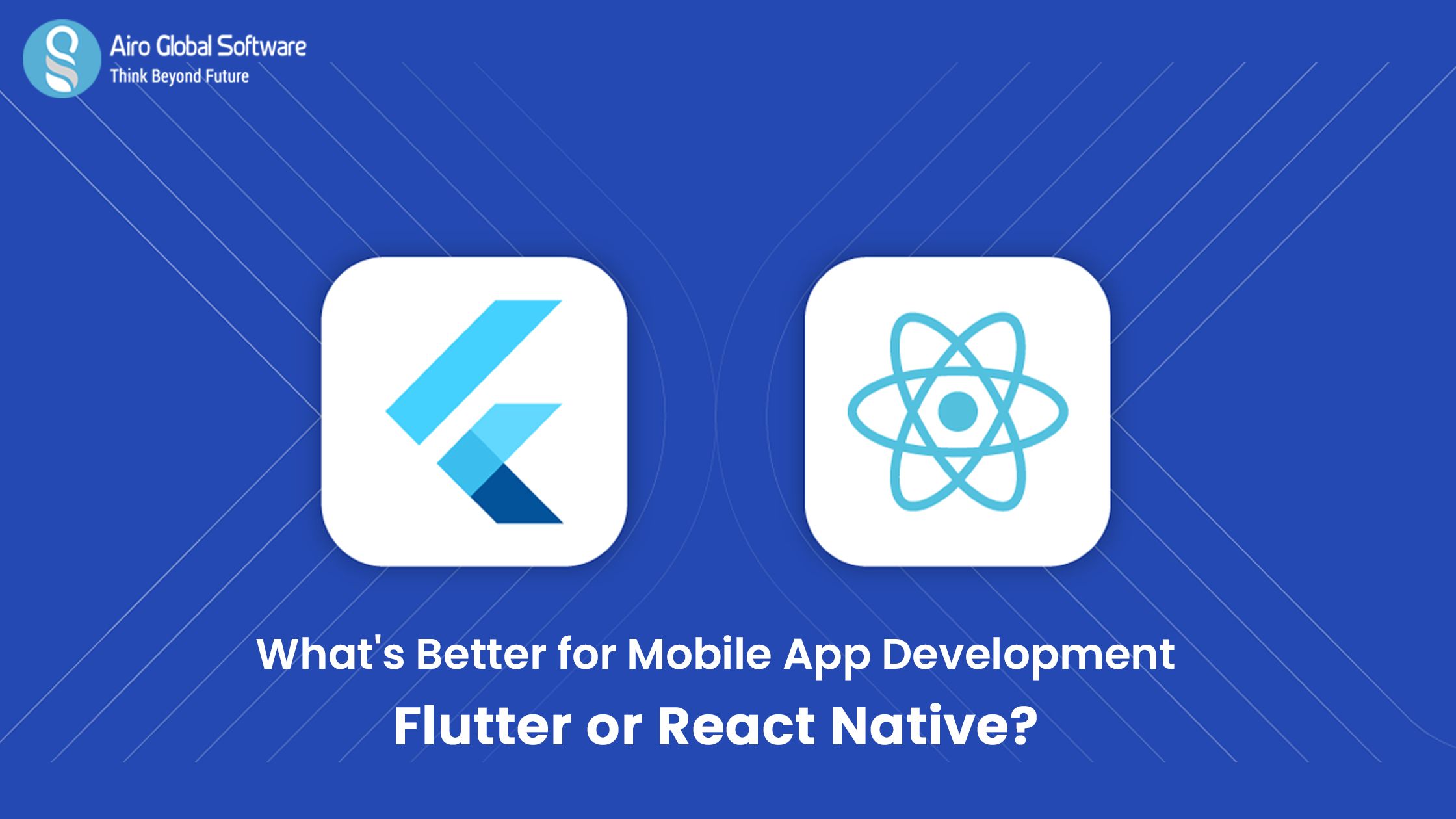
In this ever-changing IT world, knowledge and skills in all the latest technologies are priceless. Because there is such a high demand for mobile apps among users, their development will not be slowing down anytime soon. Global mobile app revenues will increase by more than $365 billion in 2023, according to Statista. That's just the tip of the iceberg!
As the number of users in the Apple Store and Google Play Market grows at breakneck speed, more and more businesses want a piece of the action by launching the next game-changing product that will take the market by storm. Do you have a great idea for a mobile app for your company? But how do you know which technology to use?
In this blog, we will compare two widely used development technologies: Flutter and React Native. Continue reading to find out which is best for your company.
What is Flutter?
Flutter is an open-source UI development toolkit that has already assisted thousands of businesses in creating appealing and user-friendly products. This UI software toolkit, released by Google in 2017, was designed to help developers create highly interactive cross-platform mobile apps with a single codebase.
Flutter is made up of two main parts:
A Software Development Kit (SDK) is a collection of tools required for app development, such as ready-made widgets and testing APIs. A UI library is made up of reusable UI elements such as buttons, sliders, and so on. To begin developing mobile apps with Flutter, you must first learn how to code in Dart. It is a client-optimized programming language used to create customized user interfaces for various platforms. The best mobile app development company in Kerala like Airo Global Software will help your business to achieve success through Flutter app development.
Apps Built with Flutter
Flutter has been used to create a number of innovative mobile apps. And many of them made significant changes in marketing, finance, e-commerce, health and wellness, and other industries. So, here are a few examples: Google Ads is an online advertising platform that allows you to track and visualize the results of your advertising campaigns.
Alibaba is a worldwide wholesale mobile marketplace that allows smartphone users to shop online. Birch Finance is a mobile app that aims to help people manage their personal finances in a more resource-efficient manner.
Coach Yourself is a fun mobile app that allows users to practice meditation and track their progress.
Airo Global Software, one of the best mobile app development service providers in Kerala will help you to build a user-friendly mobile app for your business.
What is React Native?
Facebook created React Native, an open-source mobile framework, in 2017. This framework is fantastic because it allows you to create native and cross-platform apps for platforms other than iOS and Android, such as Apple tvOS, Microsoft Universal Windows Platform (UWP), and others.
However, React Native has a lot more to offer developers. And now, let's take a closer look at the main benefits of this framework:
React Native has a wide range of native modules written in Objective-C and Java that improve operational performance in video playback and image editing. Mobile application development company in Kerala will help you build a beautiful frame work with react native.
Apps Built with React Native
Because of its seamless code deployment and simple debugging process, Facebook, Tesla, Bloomberg, and other well-known brands chose React Native over other frameworks. However, these are not the only companies that use React Native to build mobile apps. Of course, there are others:
Delivery.com is a food delivery service that allows users to order meals from nearby restaurants and cafes.
SoundCloud Pulse is a music streaming service for singers, producers, and music fans; Townske is a community of locals who share stories about their favourite spots and places with visitors, and Airbnb is a rental marketplace for travellers and homeowners to make their experiences more memorable and enjoyable.
Dart vs. JavaScript as a Programming Language
Dart is a programming language used by Flutter to create mobile apps. Dart is a client-optimized language created by Google that ensures fast compilation to ARM and 64 Machine Code.
Dart has the following advantages in mobile app development: Highly optimized and customized user interfaces for each platform (iOS and Android), Quick changes in sourcing and reloading code.
In the development process, an effective AOT (Ahead-of-Time) compilation strategy is used.
The React Native framework is built on JavaScript. Statista data show that nearly 67.8 percent of developers prefer this programming language for creating mobile apps.
JavaScript programming has a number of advantages, including a low learning curve and a large developer community; it operates on the client-server side, which means that data validation can be performed on the browser itself rather than sending it to the server and it operates on the client-server side, which means that data validation can be performed on the browser itself rather than sending it to the server.
Testing Support: Flutter vs React Native
Testing has always been an important part of developing excellent mobile apps. Without this process, we rarely know which bugs in the software system should be fixed.
So, which has better testing support: Flutter or React Native?
Let's compare the testing capabilities of these two technologies in-depth to find a clue.
First, we'll look at Flutter.
Flutter has three main testing categories for measuring the performance of your app:
Widget testing is used to test a variety of widgets such as text, screen layouts, and buttons.
Unit testing is used to determine the correctness of a single method, function, or class.
The goal of integration testing is to see if all of the widgets and services that have been tested work well together.
As an added bonus, Flutter includes well-written documentation with useful information about automated testing processes and the testing categories mentioned above.
But what about the testing capabilities of React Native?
"Knowledge is power," as the old adage goes. As a result, it's critical to identify all potential pitfalls before releasing the app to the public. And this is where testing comes into play.
Developers use JavaScript testing frameworks such as Jest to test snapshots in order to deliver a high-quality cross-platform app. Furthermore, React Native, like Flutter, has automated unit and integration testing. The main distinction between them is end-to-end testing (E2E). This testing method assists developers in determining how the app will perform from the standpoint of the user on a specific device. React Native allows testing with the E2E method on Android and iOS platforms, whereas Flutter's iOS version has yet to be released.
Performance: React Native vs Flutter
Flutter and React Native both guarantee smooth and seamless app performance. However, there are some distinctions between these technologies. And now let us untangle them!
Flutter performance provides 60 FMS or 120 FMS on devices capable of 120Hz. Another useful feature of this framework is the ability to specify the rendering time for each UI and GPU thread. However, it is not limited to this capability. Let's go over some of Flutter's other advantages and why you should use it to build your next app.
You can create animations and widgets in record time. Furthermore, the app created with this framework mimics the native components of each platform. And it's possible because of Material Design and Cupertino widgets, which ensure that all app components look and interact properly on both Android and iOS platforms.
As a result, the approaches to app performance used by React Native and Flutter differ. React Native includes a hot reload feature that displays changes in your code in real-time. Another advantage of this framework is that it is not restricted to a specific IDE and can be developed in any text editor.
Flutter Setup vs React Native Setup
Flutter and React Native have well-written documentation for iOS and Android software installations. However, there are some distinctions between them, which we will discuss below:
The React Native guide is intended for developers who have completed the necessary setup for the Android and iOS platforms.
Flutter has a flutter doctor feature that allows coders to ensure effective app installation and configuration; React Native uses Expo CLI and React Native CLI to set the development environment, and Flutter has a flutter doctor feature that allows coders to ensure effective app installation and configuration. The Flutter setup guide includes information on iOS, Android, and Integrated Development Environment setups.
Flutter and React Native UI Components and API Development
The native component is a must-have in the mobile-cross platform development process. But why is it so crucial? The answer is that your app will not feel native if it lacks a native component.
To communicate with UIs that should be rendered, React Native employs JavaScript bridges. Additionally, Objective-C APIs and Java APIs are required for rendering on iOS and Android, respectively.
In contrast, to React Native, Flutter does not rely on the platform's APIs. It has a library of widgets that help developers create interactive user interfaces, and all necessary plugins are housed in a single toolkit. Flutter also has a canvas function Object() { [native code] } that generates nearly identical user interfaces for each mobile platform. Instead, in React Native, your app UIs will look different on iOS and Android platforms.
Development Time: Flutter vs React Native
It goes without saying that fast cross-platform mobile development is a gold mine for any business owner. The more app users you have, the more benefits you will receive. A similar rule applies to the process of cross-platform mobile development. Which of these technologies will triumph in the battle of quick yet high-quality mobile app development?
So, let's get started!
There is only one disadvantage to using React Native in this situation. Plugins and other required components are stored on external servers. For example, if you want to build a routing feature in your app, you should use React Navigation as a plugin.
Recap: Which is Better for Mobile App Development: Flutter or React Native?
In conclusion, both Flutter and React Native are excellent choices for mobile app development. However, there are significant differences between them, such as time and accessibility. Because Flutter is Google's UI toolkit, all essential development components are centralized. However, we cannot say the same for React Native. The majority of third-party libraries are hosted on external servers. It may take some time to locate the necessary components for your app. However, the React Native community is larger than the Flutter community. It means that developers who know how to code in JavaScript are more easily found than those who know how to code in Dart. In this way, React Native outperforms Flutter. Additional factors, such as app complexity and development goals, can influence your decision on which of these technologies to use. And it's up to you whether to use Flutter or React Native as a framework. Get in touch with LITSLINK if you're looking for a reputable React Native development business or Flutter development services. Our software professionals will happily assist you in determining the most effective strategy to scale your company. If you have any concerns or questions about the aforementioned topic, please contact us. Please do not hesitate to get in touch with us. Your digital partner will be Airo Global Software.
E-mail id: [email protected]

Author - Johnson Augustine
Chief Technical Director and Programmer
Founder: Airo Global Software Inc
LinkedIn Profile: www.linkedin.com/in/johnsontaugustine/



 Author - Johnson Augustine
Author - Johnson Augustine



 Author - Johnson Augustine
Author - Johnson Augustine
 Author - Johnson Augustine
Author - Johnson Augustine